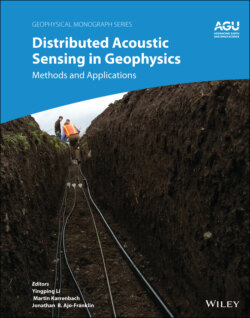Читать книгу Distributed Acoustic Sensing in Geophysics - Группа авторов - Страница 48
2.5.3. Spatial Calibration of Channels
ОглавлениеFor conventional seismic acquisition methodologies using geophones, accelerometers, or seismometers, the location of each sensor is determined by conventional surveying techniques for surface instruments or wireline depth measurement technology for instruments deployed in wells. Fiber‐optic cables pose a new challenge because the glass is distributed continuously over the entire cable, and the location of each measured channel is not specifically recorded, even though the trajectory of the cable might be surveyed accurately. A feature of fiber‐optic cables is that a longer length of glass fiber is deliberately overly stuffed into its protective outer cable, so the glass fiber does not break when the cable is put under tension and stretched.
To first order, the location of each channel of DAS data can be estimated by the time of flight of the laser light. The velocity v of light for each type of fiber is fairly accurately known. The delay between the time the laser light is pulsed into the fiber and the time the backscattered light reaches the detector is known as the “time of flight” τ. This is the two‐way time it takes the light to leave the laser, backscatter off a point in the fiber, and return to the detector; thus, the distance z along the fiber where the backscattering point is located is given by:
(2.3)
Other factors to consider are the lengths of optical cabling inside the IU and the surface cables connecting the IU to the beginning of the optical cable meant as the sensing cable, either in a well or buried in a trench or conduit. Additionally, it is possible the sensing cable might have been cut and spliced with extra cable inserted but not accounted for. These factors, including the potential uncertainty of the velocity of light in the fiber, make Equation 2.3 only an approximate solution to determining the depth or location of each DAS channel of data.
A practical solution to the spatial calibration of each channel issue is to use control points along the fiber where the location and/or depth of that point is known; for example, the location of the end of the fiber is recorded by the cable installer. Optically, it is easy to detect the end of the fiber from the lack of backscattered energy returning to the detector after a light pulse is emitted into the cable. By looking at the recorded DAS strain or strain rate data, the last channel after which there is no coherent data is easy to select as the end of the fiber and therefore can be mapped to the known location of the end of the fiber. The beginning of the sensing fiber can be located by a “tap” test at, for example, the wellhead for well‐based applications, or at the location where the surface cable connects to the sensing fiber in a buried trench or telecommunications conduit. For shallow‐buried fiber cables, additional tap tests can be combined with GPS measurements to obtain an accurate calibration of location of the channels.
Alternatively, an optical time domain reflectometer (OTDR) can be used to detect the end of the fiber and points along the fiber where it has been spliced. An OTDR detects the overall health of a fiber by estimating the light attenuation in the fiber, and it detect points where there are large losses, such as at splice points and cable terminations. If the cable installer recorded splice point locations (e.g., at the wellhead or at locations of pressure or temperature sensors), then they can be used as additional known locations along the fiber associated with the corresponding channels in DAS data. The depth or location along the fiber of each intermediate channel can then be interpolated between the known control points.
